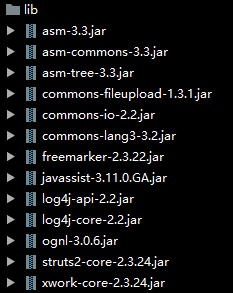1、OGNL表达式
(1)概念:
OGNL:对象导航图语言(Object Graph Navigation Language),是一种表达式语言,功能比EL表达式更为强大,它是集成在Struts中的。

在创建Struts项目的时候已经将OGNL有关的包导入了,所以,这里不需要重复导包。
(2)OGNLContext对象:
EL表达式从是一个内置对象中取值,而OGNL表达式只从OGNLContext对象中取值,该对象可以分为两部分,其中root部分可以存放任何对象,Context部分只能存放键值对。
2、OGNL初始化和取值
public class OgnlTest { public void test() throws OgnlException { User rootuser=new User("zhai","123",12);//root部分 Map<String,User> context=new HashMap<String, User>();//context部分 context.put("user1",new User("user1","111",12)); context.put("user2",new User("user2","222",13)); OgnlContext ognlContext=new OgnlContext();//创建OGNLContext对象 ognlContext.setRoot(rootuser); ognlContext.setValues(context);//将root和context部分放入到OGNLContext内部 String name= (String)Ognl.getValue("username",ognlContext,ognlContext.getRoot());//取值 Integer age=(Integer)Ognl.getValue("userage",ognlContext,ognlContext.getRoot()); String password=(String)Ognl.getValue("password",ognlContext,ognlContext.getRoot()); System.out.println("用户名:"+name+",年龄"+age+",密码:"+password); String name1= (String)Ognl.getValue("#user1.username",ognlContext,ognlContext.getRoot()); Integer age1=(Integer)Ognl.getValue("#user2.userage",ognlContext,ognlContext.getRoot()); System.out.println("用户名:"+name1+",年龄"+age1); }
(1)在初始化部分,需要先对root和context分别做初始化操作,然后将root和context放入到OGNLContext对象内部,这样初始化工作就完成了。
(2)取值操作分为两种:从root中取值和从context中取值,从root中取值的时候不需要加“#”,只需要写入变量名即可;当从context中取值的时候需要先加上“#”。
例如:"#user1.username"中user1的作用是取出键为user1的对象,即:new User("user1","111",12)这一部分,表达式#user1.username,则是从对象中取出对象的username属性的值。
3、OGNL表达式的赋值
public void test1() throws OgnlException { User rootuser=new User("zhai","123",12); Map<String,User> context=new HashMap<String, User>(); context.put("user1",new User("user1","111",12)); context.put("user2",new User("user2","222",13)); OgnlContext ognlContext=new OgnlContext(); ognlContext.setRoot(rootuser); ognlContext.setValues(context);
Ognl.getValue("username='zhang'",ognlContext,ognlContext.getRoot()); String name= (String)Ognl.getValue("username",ognlContext,ognlContext.getRoot()); System.out.println("用户名:"+name); Ognl.getValue("#user1.username='zhao'",ognlContext,ognlContext.getRoot()); String name1= (String)Ognl.getValue("#user1.username",ognlContext,ognlContext.getRoot()); System.out.println("用户名:"+name1); }
用getValue()方法对元素的值进行修改,需要注意对root和context中的变量进行赋值的不同点。
4、调用方法
(1)root:
public void test2() throws OgnlException { User rootuser=new User("zhai","123",12); Map<String,User> context=new HashMap<String, User>(); context.put("user1",new User("user1","111",12)); context.put("user2",new User("user2","222",13)); OgnlContext ognlContext=new OgnlContext(); ognlContext.setRoot(rootuser); ognlContext.setValues(context); Ognl.getValue("setUsername('ZHAI')",ognlContext,ognlContext.getRoot()); String name=(String) Ognl.getValue("getUsername()",ognlContext,ognlContext.getRoot()); System.out.println("用户名:"+name); }

先动用User类中user对象的set方法,对user对象的username值进行修改,修改后在调用get方法取出对象的值。
(2)context:
public void test2() throws OgnlException { User rootuser=new User("zhai","123",12); Map<String,User> context=new HashMap<String, User>(); context.put("user1",new User("user1","111",12)); context.put("user2",new User("user2","222",13)); OgnlContext ognlContext=new OgnlContext(); ognlContext.setRoot(rootuser); ognlContext.setValues(context); Ognl.getValue("#user1.setUsername('ZHAI')",ognlContext,ognlContext.getRoot()); String name=(String) Ognl.getValue("#user1.getUsername()",ognlContext,ognlContext.getRoot()); System.out.println("用户名:"+name); }

先用“#user1”调用对象user1,然后对user1对象进行赋值,在进行取值。
(3)调用自定义的静态方法:
先创建一个静态方法:
public class Hello { public static String nihao(String name){ return "你好,"+name; } }
用OGNL表达式调用静态方法:
public void test3() throws OgnlException { User rootuser=new User("zhai","123",12); Map<String,User> context=new HashMap<String, User>(); context.put("user1",new User("user1","111",12)); context.put("user2",new User("user2","222",13)); OgnlContext ognlContext=new OgnlContext(); ognlContext.setRoot(rootuser); ognlContext.setValues(context); String string=(String) Ognl.getValue("@pers.zhb.ognl.Hello@nihao('zhai')",ognlContext,ognlContext.getRoot()); System.out.println(string); }

关键点是利用完整类名和静态方法名实现对方法的调用。
(4)调用已有的静态方法或属性:
public void test3() throws OgnlException { User rootuser=new User("zhai","123",12); Map<String,User> context=new HashMap<String, User>(); context.put("user1",new User("user1","111",12)); context.put("user2",new User("user2","222",13)); OgnlContext ognlContext=new OgnlContext(); ognlContext.setRoot(rootuser); ognlContext.setValues(context); Double aDouble= (Double) Ognl.getValue("@java.lang.Math@PI",ognlContext,ognlContext.getRoot()); System.out.println(aDouble); }

和调用自定义的静态方法或属性一样,只需完整类名和方法或属性名即可。
5、集合对象
(1)list集合:
public void test4() throws OgnlException {
User rootuser=new User("zhai","123",12);
Map<String,User> context=new HashMap<String, User>();
context.put("user1",new User("user1","111",12));
context.put("user2",new User("user2","222",13));
OgnlContext ognlContext=new OgnlContext();
ognlContext.setRoot(rootuser);
ognlContext.setValues(context);
String string1=(String) Ognl.getValue("{'wu','han','jia','you'}[1]",ognlContext,ognlContext.getRoot());
String string2=(String) Ognl.getValue("{'wu','han','jia','you'}.get(1)",ognlContext,ognlContext.getRoot());
System.out.println(string1);
System.out.println(string2);
}

{'wu','han','jia','you'}为创建的一个list集合对象,以上程序为分别用两种方式获取list集合中的元素。
(2)map集合:
public void test5() throws OgnlException {
User rootuser=new User("zhai","123",12);
Map<String,User> context=new HashMap<String, User>();
context.put("user1",new User("user1","111",12));
context.put("user2",new User("user2","222",13));
OgnlContext ognlContext=new OgnlContext();
ognlContext.setRoot(rootuser);
ognlContext.setValues(context);
String string1=(String) Ognl.getValue("#{'name':'zhao','age':12}['name']",ognlContext,ognlContext.getRoot());
System.out.println(string1);
}
与list集合不同,创建时需要在集合前面加上“#”,用键取值。